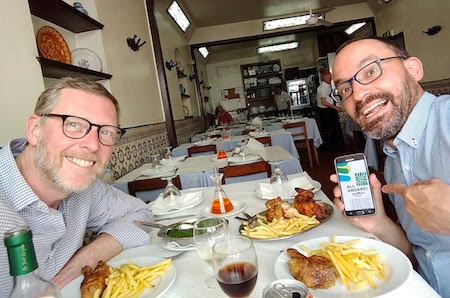
Whenever those days of saudade hit, I often remember the flavors of Portugal. Like most people who enjoy food, memories & meals go hand in hand. Tastes are a vivid part of the travel experience & adopting a new diet is one of the best ways to experience a country. The variety of Portuguese gastronomy would provide enough material for an entire blog, so just consider this post a taste of what Portugal has to offer…
A café com leite or meia-leite can jump start the morning but even better is the Portuguese version of a latté. Order a galão da máquina to get a tall & extremely hot glass of goodness, stirrable with an iced tea spoon. If you don’t order it da máquina (“from the machine”… in other words, with espresso), chances are that they will make it with regular brewed coffee that’s been sitting in a vat for some time. Not something I want to taste first thing in the morning. Espresso makes everything better:
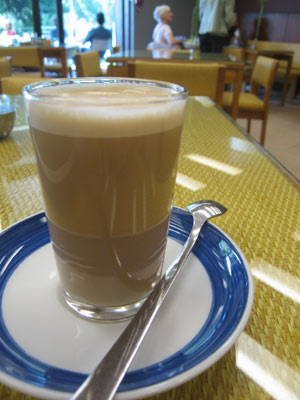
One of my all-time favorite breakfast pastries is the puffy pão de Deus (“bread of God”). It has to be good with a name like that. Barely sweet, made with milk & with a wonderful coconut topping dusted with powdered sugar, it’s usually served cut into quarters. Otherwise, it would be a mouthful. Of course always eat your pastry with a napkin. Be civilized 🙂
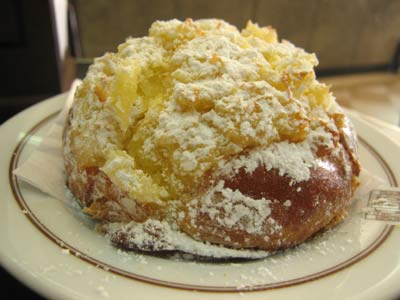
Quick word about meals in Portugal: After sitting down & placing your order, restaurants bring out appetizers such as bread, butter, paté, olives & cheese. Fancier places may serve tuna or octopus salad, some cold cuts, the sky is the limit. None of this is free or included in the price of the meal. If you don’t touch them, then you aren’t charged. But eat one olive & you pay for the plate. Ditto for the bread. So what? It usually only adds one or two euros to the bill. Some guidebooks suggest refusing these tasty treats, but that couldn’t be more rude. Never, ever waive them away. Just have a quick look at your bill to ensure that you’ve been charged correctly. Homier places will often calculate the bill along with you by writing on your paper tablecloth.
The following two photos are my favorite appetizers. Sardine paté comes in small tins like jam or jelly. Open it & there’s the unmistakable aroma of cat food. The consistency is about the same as well. While I’ve never tasted cat food, if it’s anything like paté de sardinha then all those Whiskas commercials were easy to film. This stuff is tops.
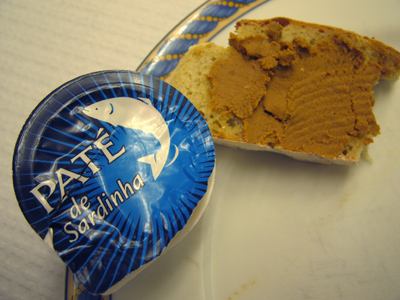
There are hundreds of cheeses in Portugal but my fave is queijo fresco (fresh cheese). Made from sheep’s milk, barely fermented & wonderfully neutral, this is a slightly more solid version of what Americans know as cottage cheese. It’s great in salads, on sandwiches, by itself or with a nice bit of bread:
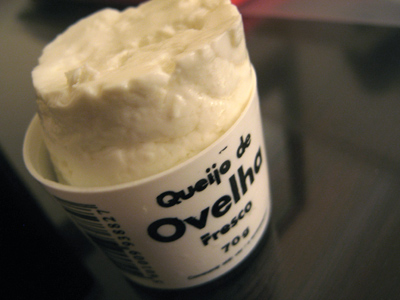
Due to their proximity, people often compare Spain & Portugal. It’s inevitable. And foodwise, visitors often complain about the lack of veggies in the Spanish diet. While that has changed over the last decade, in Portugal vegetables automatically accompany main courses. The Museu do Oriente has one of the most attractive salad spreads in Lisboa:
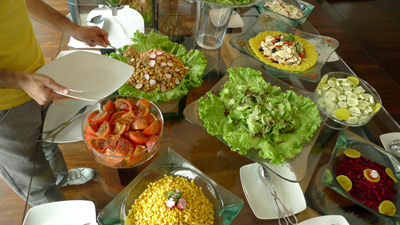
Ahhhh, one of the most typical dishes of Portugal —sardinhas grelhadas/assadas. Grilled sardines are the perfect standby & before saying you don’t like sardines, it’s probably because you’ve never had them fresh. What a treat. Just take the scales off, cover them with sea salt, throw ’em on the grill & that’s it. At touristy spots, they’ll be gutted & pristine. But most places don’t bother. It takes a little practice to know how to get around the stomach & other internal bits, but the reward is worth it. Best advice: Be sure to learn how to use a fish knife… a handy skill to have in Portugal:
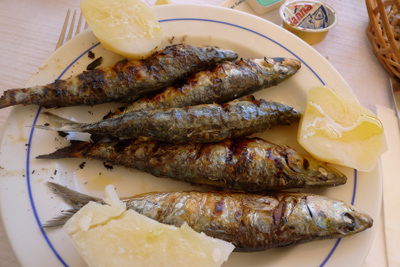
While fish & vegetables are staples of the Portuguese diet, make no mistake. They equally love meat. In fact, Portugal has a selection of cured meats as varied as Spain. While they aren’t as addicted to jamón serrano like their neighbors, the equivalent presunto is easy to find. What’s even tastier is a big slab of grilled pork –can’t miss it in Évora— and every bit as good as the famous pork & clams pairing.
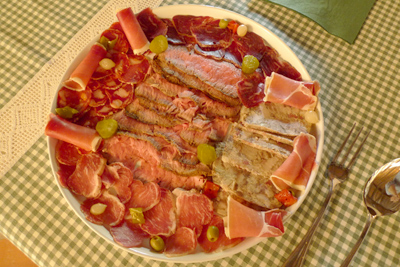
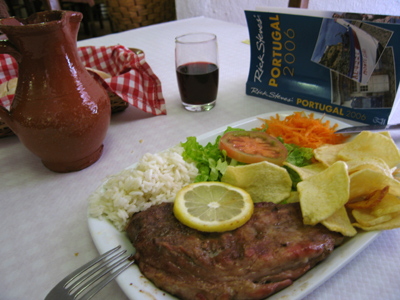
On those cold winter days, nothing provides energy like a cozido. It’s pretty much the same as the Spanish cocido… as much carbs & protein you can cram on a plate. Served on a bed of rice, boiled potatoes & garbanzo beans, a few choice cuts of cow & pig accompany a little bit of overcooked cabbage. Top it off with some sausage, blood sausage & some other mystery meat, & you’ll be working the fields for hours. It may not sound very appetizing but it’s really, really good. Once a month.
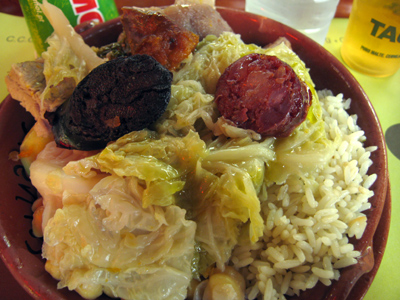
Coffee is excellent in Portugal. It’s standard southern Europe, coffee-ground-with-sugar espresso, & almost mandatory after a meal. You can ask for a café, café corto, cafezinho, or bica & it fills half of an espresso cup. Dump in some sugar, & it’s an automatic dessert. Ask for that shot of coffee cheio, or uma bica cheia, & it will fill the whole cup. Hardcore addicts will want um italiano which is more concentrated than a bica, filling about 1/3 of the cup:
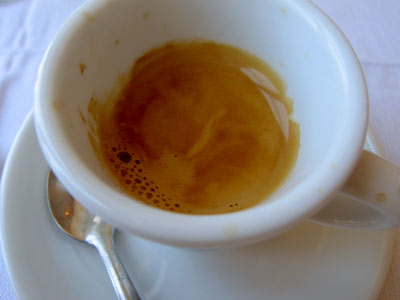
I used to get intimidated whenever I walked into a pastry shop in Portugal. I have no problem communicating, but I never knew more than a handful of names for the endless variety of sweets. I couldn’t find a lot of info online, so I started paying attention in the morning at the coffee shop & listened to what other people ordered. A few years ago I had the luck to meet the nicest pastry shop owner in Braga… she patiently answered all my questions & even better, gave me a box of pastries for free because she was closing for the day! I still have a long way to go with learning regional varieties, but if you ever come to Portugal, don’t miss the following…
First, the oddly-named salame de chocolate (chocolate salami). No, they aren’t mixing meat & chocolate. Look at it closely. When sliced, the cookies surrounded by a dense chocolate fudge cake reminded someone of salami. This can be truly fantastic or uninspiringly average, but of course it all depends on the quality of the chocolate used:
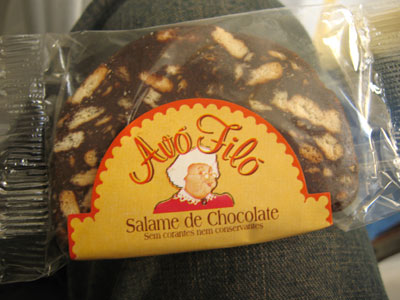
I’ve never had a walnut cake (bolo de noz) as good anywhere else. It’s moist & slightly spicy with the nuts on top being the crunchiest:
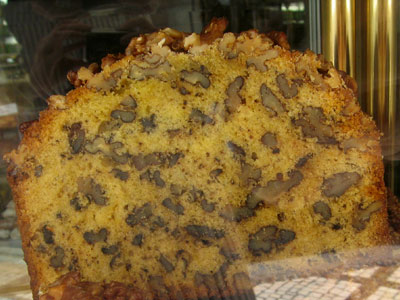
The most famous sweet in the entire country is the scrumptious pastel de nata. Imagine the flakiest, puff pastry crust filled with custard, baked until crispy on the top. They’re available everywhere, but no one makes them like the Pasteis de Belém bakery in Lisboa. Only a few people know their top secret recipe. Called a pastel de Belém only at that shop, wait in line to get one straight out of the oven & sprinkle on as much cinnamon & powdered sugar as you like. Heaven.
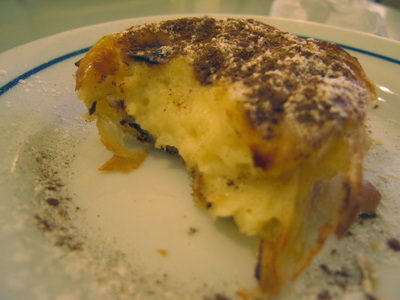
Bolo de amêndoa —rolled up almond cake. How can something so simple be so darn good? Moist, rolled cakes come in several variations in Portugal, even including orange (laranja).
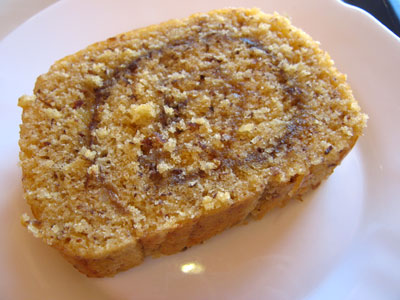
Native to Porto, the famous francesinha is a tasty heart attack on a plate… a sandwich of various meats covered with melted cheese, a fried egg, lots of gravy & surrounded by fries. Prepare yourself for a nap after eating this for lunch:
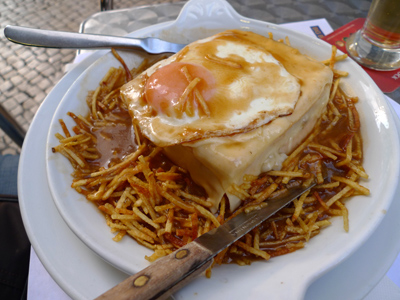
Meats like rabbit & duck are popular. Thankfully. The best rabbit stew I’ve had in my life was in Sagres, & roasted duck –skin & all– mixed with cuts of pork is another staple to try: arroz de pato.
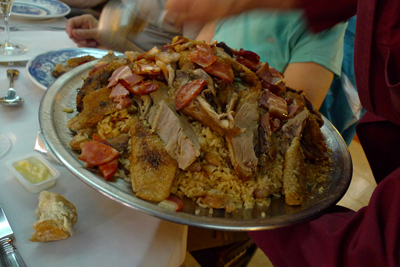
Another Portuguese concoction that I can’t get enough of is açorda de mariscos. It can come in an earthenware bowl, but this is my favorite version… in a big bread bowl. It’s basically the softest part of a loaf of bread cooked in the oven with a variety of seafood (mussels, clams, shrimp, squid, crab, whatever) & lots of garlic & coriander until it it gets a bit mushy. Crack an egg on top for presentation. At the table, either the waiter or the customer mixes it all together; the heat of the bread-seafood mixture cooks the egg immediately. Interactive food is fun:
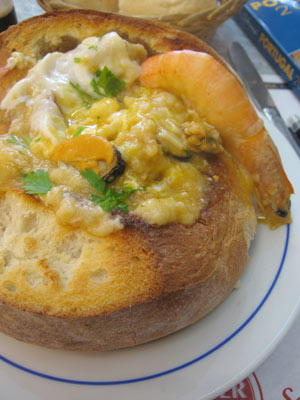
My first meal when arriving in Lisboa, without question, is frango piri-piri (roasted chicken with a hot pepper sauce). A dish that is good most everywhere —Spain certainly does it very well— but the added fun of painting on the hotness makes this one of my favorite tastes of Portugal. Go to Restaurante Bonjardim, sit outside & say hi to Fernando or go to the upstairs dining room in the branch across the street for a bit of 1950s Portuguese decor & no street artists:
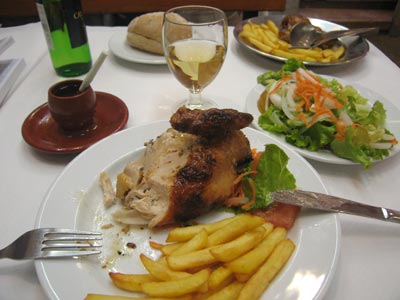
Finally, my all time favorite taste of Portugal: ginjinha. A wonderful liqueur made from “cherries”… actually a cherry-like fruit from a bush in central Portugal. Fill a vat with this fruit, dump a lot of grappa inside with muito sugar, & the result is magic. Order it with or without the cherries, but I always get it with because the fruit absorbs much of the alcohol. You drink it on the street in front of the locale (that’s a whole lot of fun), but your hands get sticky & so do your shoes. It has that much sugar.
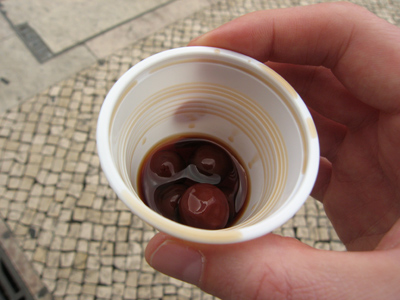
Lucky me, I have yogurt and fruit for dinner tonight…
I wonder: what do tourists write about our food when the go back home? I remember when Madonna came to film Evita and said something like she had tried here the greasiest meals ever (as if Americans were the kings of healthy food!).
Probably healthier than most of the photos here 🙂 There are a lot of blogs about food in BA. I think what most people ask is, “Where’s the spice?” & of course they rave about the beef. Hadn’t heard that comment from Madonna though… I’ll have to look that up & read more about it. Personally I don’t find the food here very greasy but I make milanesas al horno & try to have fries only once or twice per month.
Now I’m hungry.
Here she is, the ungrateful bitch:
“[Evita’s] favorite meal was breaded panfried veal with a fried egg on top and French fries. I’m going to try that tomorrow. The only way to eat sensibly in this country is not to eat. The concept of non-fat has not made its way here yet. ”
“It would be very easy to get an enourmously fat ass on this shoot, as there are no gyms and no decent food. I made a solemn promise to myself to start eating better, but every time I go to a meeting or an interview, someone whips out the trays of croissants and petits fours and bonbons”.
From “The Madonna Diaries” that she “wrote” for Vanity Fair magazine.
http://www.madonna-online.ch/m-online/interviews/interview-sites/96-11_vanity-fair-evita-diaries.htm
My god… I should have known that article existed but I’ve never seen it before. Thanks! It was cool to read about her take on Recoleta Cemetery… that’s definitely going on the other blog. What I wouldn’t give for a photo of her by the tomb of Eva Perón. The cemetery was probably closed for her visit. Such a shame. What a perfect photo op!
Thanks for the link. I printed this article to use in our New Year’s trip to Lisbon.
Glad you’re going to Lisboa! Hope you find it useful… I’ll send you another link via Twitter with more specific tips. If there’s one place I know like BsAs, it’s Lisboa 🙂